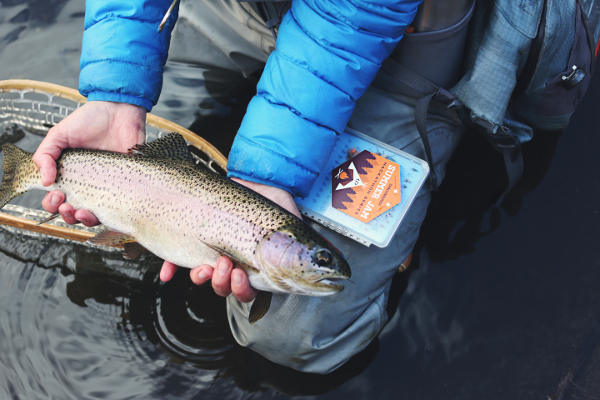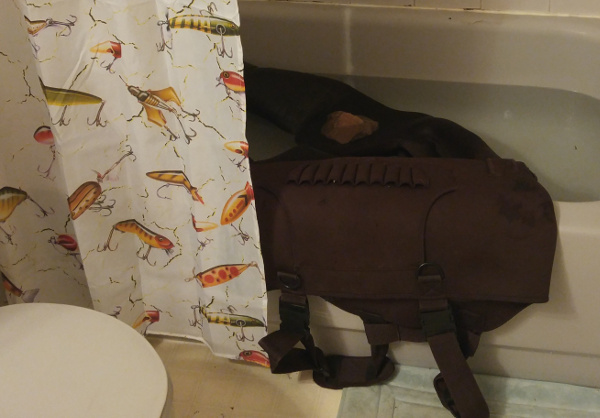It’s the morning of the first day of fishing season. I packed all my fly fishing gear in the car the night before. In the morning, I rush out to my (not so) secret spot to get there before anyone else and wait for the sun to rise. Successful in claiming the best spot on the river, I start fishing and cast a few times, but when I comes time to change flies, the scissors are no where to be found! Tragically I was reduced to cutting line with my teeth for the day (seriously, don’t do that) which only resulted in sore teeth and messy tag ends.

The above situation is a good example of why it pays to plan before the start of a new fishing season. While forgetting scissors certainly put a damper on the day, imagine if my waders had a leak, or I forgot to bring any tippet! Things can get lost, worn, broken, or simply just put out of place in the off season, and it’s a good idea to look everything over to make sure you’re ready for a great season of fishing. Below is a checklist of some things worth looking at before starting a new fishing season.
Check Your Equipment
Rod and Reel
Perhaps the most important piece of fly fishing equipment for any angler, you’re going to have a rough time fishing if you run into problems with your rod or reel. Test the reel by pulling line and then reeling the line back in. I actually discovered this year that my drag wasn’t engaging with one of my fly reels, which required a relatively straight forward repair to get it working again. You also want to make sure that the fly reel is retrieving/releasing line properly without slipping or stuttering. If you do need to repair the fly reel, be sure not to pinch the fly line when taking it apart.
Give the rod a quick look over to ensure it wasn’t damaged in storage. If rods are moved around while being stored it’s easy enough to accidentally snap the end off of them.
Waders
Test your waders for leaks. I do this by submerging them chest deep in the tub (I like to do this when the wife isn’t home) and letting them sit for a while. My waders are very buoyant, so I had to sink them with rocks I had lying around the house. If you can’t get the waders completely submerged, just switch positions a few times. After the waders have been sitting for an hour or so, take them out and check if they’re wet on the inside.

If the waders are wet on the inside, you likely have a leak. I can only say good things about aquaseal’s repair adhesive, as it’s been able to fix any rips I’ve had in my waders.
Fly line
Check the fly line for any kinks, knots, or abrasions. If you do find any damage it can sometimes be repairable. Certainly, if the damage is minor I would attempt a repair; however, don’t try to repair a heavily damaged fly line, it’s not worth the risk of losing that once in a lifetime trophy fish! If you’re reusing the leader from last year check the line over looking for the same things, if you find anything wrong with the leader chuck it and buy a new one.
Fishing Net
Check your net for any holes or damage, having a monster trout slip away through a damaged net before having the chance t o take a picture would be heartbreaking!
If you use a net retractor, make sure it’s operating properly. Hold it up in the air with the net attached and make sure it’s able to hold the net in place. After ensuring it can hold the weight of the net, pull on it to test and make sure it lets line out smoothly.
Take Inventory
Many of us anglers are gear junkies, while others take a more minimalist approach. Regardless of how much fishing gear you haul out on the water with you, it’s easy to forget something. Here’s a fishing checklist of some important equipment to bring with you.
- Leaders and tippet: Make sure you have a leader or two in reserve in case you need them. Having a few rolls of both leaders and tippet in different sizes will ensure you’re ready to tackle a range of different fishing situations
- Flies: Flies can rust in the off season. Check and throw out any rusted or disintegrated flies. Take note of any flies you may want to stock up on and either take a trip to the local fly shop or spend a night at the vise to replenish your supply. If you’re a lure angler, check the hooks on the lures and replace any rusted ones.
- Scissors: Only the most foolish among use would forget such an essential piece of equipment. Make sure it’s packed!
- Needlenose pliers: Pliers are a must have tool for any angler. From pinching barbs to removing hooks (from fish or yourself!), you’ll miss them if you don’t have it with you.
- Rope measuring tape: For measuring that monster fish you’re totally going to catch.
- Floatant: Check your floatant bottles to make sure you still have plenty for the up coming season, if not then stock up!
- Indicators: If you’re the nymphing type (pro-tip, if your not, you should be), make sure you have indicators stashed in your fishing vest somewhere. If you use the foam type of indicators with wooden pegs, make sure you have enough pegs as well.
- Weight: Getting into heresy territory here, but be sure to pack some small split shot if you’re nymphing as well, it can be the difference between a full day and getting skunked.
- Insect repellent and sunscreen: These two items make fishing so much more pleasant. The only flies you’re dealing with should be on the end of the line, and you’re exposed to a surprisingly large amount of sun even in during overcast casts as the rays reflect off the water.
- Bait knife or pocket knife: Useful if retaining certain species of fish that should be bled to keep fresh longer. Can be used to cut line if you lose your scissors.
- Camera Batteries: If you’re the type to film your angling, make sure your cameras working and batteries are fully charged!
- Drinks! Whether it be beer, water, coffee, Gatorade or any combination of the four, make sure you bring drinks! Also, don’t litter, and make sure you take any trash home with you.
Be sure to check all the pockets in your fly vest and waders to see if you have any equipment you may have forgotten about.
If you buy anything below, I get a bit of beer money (commission).
Purchase Fishing License
This may seem like a no-brainer, but make sure you actually buy a fishing license before opening day. If not, you’ll have to wait until an outlet that sells fishing licenses opens on opening day before you can actually start fishing. You’re obviously going to miss out on the morning fishing if you go this route, and I guarantee by the time you actually get out on the river, all the good spots will be taken.
Worst case scenario, you forget about it entirely in the excitement of opening day morning and end up fishing illegally while not even realising it.
Read the Fishing Regulations
Even if you’ve been fishing an area for a long time, read the current year’s fishing regulations in their entirety. Many rivers have special regulations or closure that should be taken into consideration. Fishing dates, retention sizes, amounts, and even legal species can also change year to year.
That’s my checklist for starting a new fishing season. Please let me know in the comments below if I’ve overlooked anything. As a final thought, It wouldn’t hurt to make sure your vehicle is fully gased/charged up the night before. Just as important as starting a new season correctly is ending a season the right way.

I can’t even begin to count the number of these I’ve committed over the years while rushing to get out on the water. I never leave without checking my list. It may sound funny, but I also bring a change of clothes just in case and a roll of toilet paper, also just in case.